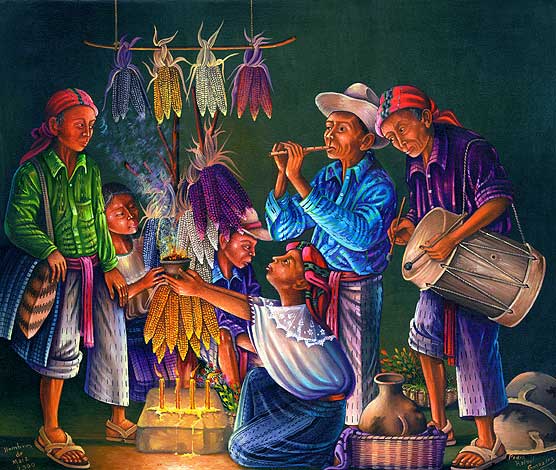

Hombres de Maiz, Ritos
(Men of Corn, Rites)
2000
20" x 24", oil on canvas.
Pedro Rafael Gonzalez Chavajay
Theme and Execution: Exceptional
Hombres de Maiz combines a strong, purely Mayan theme with an outstanding execution of the painting. It is one of two with the same title, the first dealing with the growing of the corn. This painting shows the blessing of the corn prior to planting. The blessing of the corn is a Mayan ritual which has endured over through the centuries, existing essentially unchanged from pre-conquest times. This Mayan ritual has survived because it did not threaten the Catholic religion; Christians have always blessed their crops, too. The four colors of corn (white, yellow, red and blue) which hang overhead and on the post represent the colors of the four directions. The corn and the colors are deeply significant to the Mayans. Traditional instruments tambour [drum] and chirimilla [flute], flowers, candles and pom [incense] are part of the ceremony. Traditional pre-conquest Mayan music, instruments and dancing were forbidden by the Catholic church so what Mayan music now exists, hundreds of years later, may not have any relation to pre-conquest music1. The ceremony would be performed in the Tzíutuhil language. Because there is no book included in the painting of this ritual (the book would be the Bible) we know that Pedro Rafael intended to represent the purely Mayan version of this ritual which would not have any Christian references. The dress of the people in the painting indicate that they are from San Pedro. The fact that pants are unadorned with embroidered designs at the bottom and that the womenís huipiles are white with a touch of sky blue indicate that the time frame is probably before about 1950.
Pedro Rafael has said many times that he spends as much time thinking about the theme and composition of a small painting as he does for a large painting. It is only applying the paint itself which takes longer for a large work. For him half of the work is done before the painting is ever started. This painting, although small, is probably Pedro Rafaelís most powerful thoroughly Mayan work.
1
In 1964 Jacques Jangoux recorded the music of a chirmilla and tambour from San Pedro la Laguna and San Juan la Laguna. Smithsonian Folkways: Music of Guatemala 1.